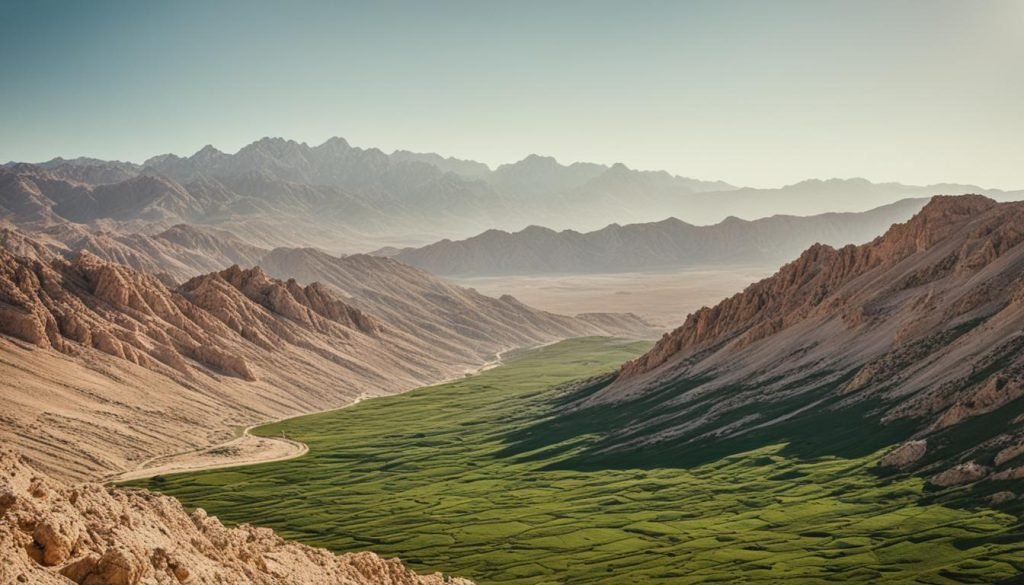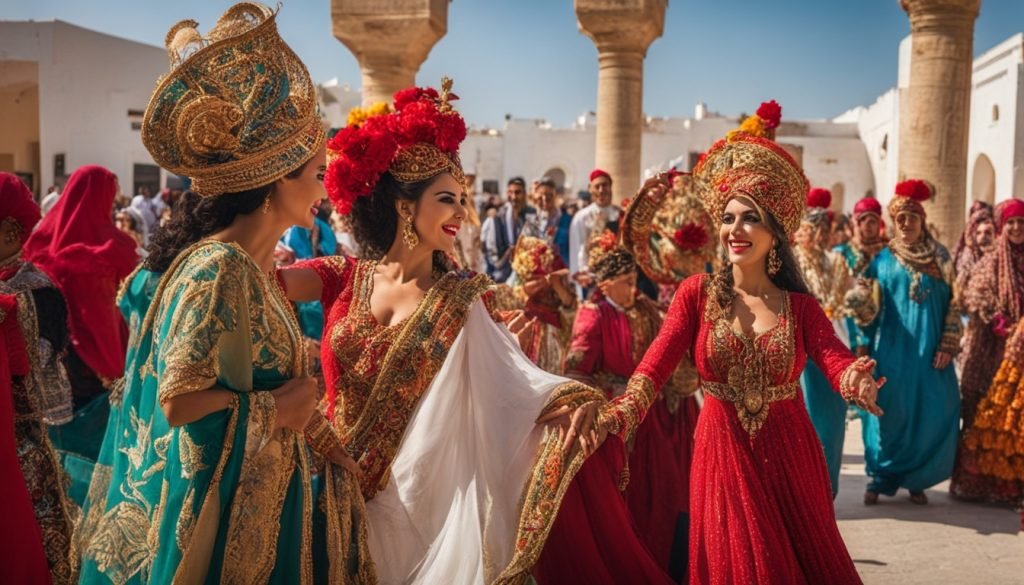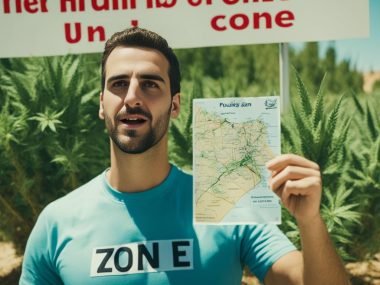Did you know millions visit Tunisia every year? This makes it a top spot in Africa for travel. When I explored Tunisia’s landmarks and its history-filled landscapes, I was amazed. This North African country combines a beautiful Mediterranean coast with the vast Sahara Desert. Tunisia has been important throughout history. It connects the Mediterranean world with Africa’s heart, making it a place of rich cultural mix.
Tunisia’s culture is colourful, shaped by Ottoman and French rulers. It’s home to Jewish, Christian, and Muslim communities living together. In Tunis, the capital, old Arab markets meet new buildings. Walking through the busy medina, the country’s vibrant spirit touched me. History and today come together here smoothly. This friendly, easygoing way of life attracts more visitors from Europe and America every year.
Key Takeaways
- Tunisia’s strategic location has historically made it a cultural bridge between the Mediterranean and Africa.
- The country’s landscape ranges from Mediterranean coastlines to the sandy expanses of the Sahara Desert.
- Tunisia’s culture is a vibrant blend of influences from Ottoman, French, Jewish, Christian, and Muslim populations.
- Tunis, the capital city, combines ancient markets and modern structures, reflecting a blend of history and contemporary growth.
- Renowned for their hospitality, Tunisians contribute to the country’s appeal as a prime destination for travellers.
Tunisia has bustling cities and calm deserts, offering varied and rich travel experiences. Whether you want to see Tunisia’s landmarks, take photos of your travels, or find great vacation spots, this country has much to offer. It promises an adventure you will always remember.
An Overview of Tunisia
Tunisia is a land of beauty and contrast. From fertile plains in the coastal Sahel to the south’s vast desert. It offers unique sights for every visitor.
The Geographical Diversity
The Tunisian landscape features mountains and the Sahara desert. The Dorsale mountain range and Mount Chambi, standing tall at 1,500 metres, are highlights. The Great Eastern Erg in the south shows a stark contrast to the green coasts.
As you travel, the varied scenery unveils. It’s a paradise for those who love landscapes. Tunisia’s diverse geography makes it special.
Climate and Weather Patterns
The climate in Tunisia changes from north to south. The north enjoys a Mediterranean climate with rainy winters and dry summers. The south, however, is dry, affected by hot sirocco winds.
This variety in climate offers different activities all year round. It makes Tunisia a great place to visit, from its mountainous north to the southern Sahara.
A Historical Perspective
Tunisia’s history is rich and varied. It’s like a tapestry with lots of different bits making it whole. It includes ancient times and many cultures. These have shaped Tunisia’s culture and buildings in lasting ways.
Ancient Carthage
The tale of Tunisia begins with Ancient Carthage. It was set up in the 9th century BCE by settlers from Phoenicia. They were led by Princess Dido. Carthage was strong because of its navy and trade spot. But it fell after fighting Rome in the Punic Wars. The ruins of Carthage show us how important it was in history.
The Roman Influence
After Carthage fell, the Romans took over. They left a big mark on Tunisia, seen in amazing buildings. For instance, the big amphitheatre in El Djem and old Roman houses in Dougga. These places show the reach and skill of Rome’s builders.
The Ottoman Empire
Then the Ottoman Empire came to Tunisia. They added new things to Tunisia’s culture and ways of running things. They built grand buildings and set up new social ways. Arts, culture, and trade grew a lot under their rule. This time added something special to Tunisia’s character.
French Colonial Period
The time of French rule also stands out in Tunisia’s history. It lasted until Tunisia became independent in 1956. This period brought a lot of change and development. Tunis, the capital, shows this mix of new and old from that time. The French impact is a big part of Tunisia’s modern story.
Exploring Tunis: The Capital City
When you visit Tunis, you’ll find a rich mix of history and culture. This lively city is known for its different areas. You can see the old medina streets, busy modern districts, and peaceful waterfronts.
Historic Medina
The medina in Tunis is a UNESCO World Heritage site. It’s full of narrow lanes, markets, and mosques from the past. You’ll find the Zitouna Mosque and many other beautiful buildings there.
Walking through the medina lets you see real Tunisian life. Craftsmen make traditional goods here. You can also buy spices, textiles, and jewellery.
Modern Attractions
The modern part of Tunis is just as interesting. It blends well with the oldest parts of the city. The city centre has up-to-date shopping places, cafés, and restaurants.
You’ll see old and new sides of Tunis here. The city has changed a lot over time. A walk on Avenue Habib Bourguiba shows the mix of old and new buildings.
The Waterfront
Tunis’s waterfront is stunning. Walking along La Goulette gives beautiful sea views. It’s perfect for relaxing or enjoying a seafood meal.
The waterfront is calm and pretty, great for unwinding. It shows the city’s lovely coastal side.
In Tunis, you can dive into a mix of old and new. Visit the lively medina, trendy avenues, or calm waterfront. Each place offers something special to see and do.
The Mountain Ranges
Tunisia has amazing mountains that make the country very special. These mountains have lovely views and are great for people who love nature.

Tunisian Dorsale
The Tunisian Dorsale is a big mountain range in the north of Tunisia. It goes across the country and makes the land look very interesting. It is full of plants and animals and looks very pretty.
People who want to see Tunisia’s beautiful nature will love the Tunisian Dorsale. It’s perfect for exploring and going on adventures.
Mount Chambi
Mount Chambi is the tallest mountain in Tunisia. It’s more than 1500 metres high. Climbing it can be hard but very rewarding because of the stunning views and nature.
Kroumirie Mountains
The Kroumirie Mountains are in the northwest of Tunisia. They are very tall, with forests and lots of animals. It’s a peaceful place for nature lovers to explore and enjoy quiet walks.
Here’s a brief comparison of Tunisia’s three main mountain ranges:
| Mountain Range | Location | Peak Height | Key Features |
|---|---|---|---|
| Tunisian Dorsale | Northern Tunisia | – | Diverse flora and fauna, scenic views |
| Mount Chambi | Central Dorsale | Over 1500 metres | Highest peak, rich biodiversity |
| Kroumirie Mountains | Northwestern Tunisia | Over 900 metres | Dense forests, hiking trails |
Visiting the Sahara Desert
Exploring the Sahara Desert in Tunisia is amazing. It mixes calm and wonder. Tunisia’s southern region, part of the Great Eastern Erg, has lots of sand. It attracts those looking for adventures and beauty. This desert adventure stays with you for a long time.
In the Sahara, you can find oases and streams among the sand. These sights make taking photos in the Sahara amazing. The ever-changing dunes add beauty to each shot.
Going on a Sahara Desert adventure is thrilling. You get to explore huge areas of sand. You also learn about the culture of people living there. They have lived with this tough landscape for hundreds of years.
“The Sahara’s endless dunes are not merely a photographer’s dream but a testament to nature’s grandeur.”
Every visit shows more of this beautiful desert. Going on Sahara desert tours in Tunisia is a must for explorers. The thrill of adventure and the peace seen in photos stand out. The Sahara Desert symbolises Tunisia’s natural beauty.
Understanding how life works here makes the Sahara trip special. It tells a story of survival and beauty among the sands.
- Vast sandy dunes
- Occasional oases
- Rare seasonal streams
- Unique desert ecosystem
Each part makes the visit to the Sahara Desert unforgettable. Going to the Sahara in Tunisia shows the beauty of the wild and untamed.
The Coastal Delights
Tunisia’s coast offers lots to see and do. It has natural beauty and fun stuff for visitors. People love its Mediterranean charm.
Sahel Region
The Sahel Region of Tunisia is famous for more than just farming. It has beautiful beaches and olive groves. These reach down to the blue Mediterranean Sea. This area is a must-see for its history and beauty.
Pristine Beaches
Tunisia’s beaches are stunning. They have over 1,300 kilometres of coast. There are quiet spots and lively ones too. The sand is golden, and the water is clear. It’s perfect for enjoying the sun or taking long walks.
Water Activities and Sports
Water sports in Tunisia are great fun. The sea is perfect for windsurfing, kiteboarding, and diving. Places like Hammamet and Sousse have everything you need. Trying these sports is exciting. It offers a view of amazing sea life.
Iconic Tunisian Landmarks
Tunisia has a rich history and diverse culture shown in its landmarks. These places show how important Tunisia’s culture is. They attract people who love travel and history.
The Great Mosque of Kairouan
The Great Mosque of Kairouan is a key religious spot. It showcases early Islamic architecture. Founded in 670 AD, it highlights Kairouan’s rich past.
The Medina of Sousse
The Medina of Sousse is a UNESCO World Heritage site. It shows the city’s significant past and strength. Its ancient walls and narrow paths tell stories of Tunisia’s medieval times.
El Djem Amphitheatre
The El Djem Amphitheatre is tied to Tunisia’s Roman era. It was once a place for gladiator fights. It is almost as grand as the Roman Colosseum. It’s a must-see for its historical insights.
| Landmark | Location | Historical Significance |
|---|---|---|
| Great Mosque of Kairouan | Kairouan | Early Islamic Architecture |
| Medina of Sousse | Sousse | UNESCO World Heritage site |
| El Djem Amphitheatre | El Djem | Roman Influence |
These landmarks highlight Tunisia’s cultural wealth. From the Great Mosque of Kairouan to the El Djem Amphitheatre, they draw people in. Tunisia’s heritage is truly captivating.
The Urban and Rural Contrast
Tunisia shows a vivid mix of city life and the calm countryside. This mix makes the country special. It blends the energy of cities with the peaceful rural traditions.
Life in Tunisian Cities
Cities like Tunis offer a lively mix of old and new. Historic markets blend with modern shops and offices. City people live a blend of traditions and new styles.
There are busy markets, schools, and festivals in cities. These show how Tunisia is moving forward but still remembers its culture.
Rural Villages
The countryside of Tunisia is filled with beautiful villages. Life here is slow and everyone helps each other. The villages are strong communities.
Houses are made from local stuff, showing how clever the villagers are. Visitors love the friendly feel and the beauty of rural Tunisia.
Traditional Farming Practices
Farming is very important in the countryside. Farmers use old ways of farming passed down through families. They grow olives, grapes, and cereals.
They mix old farming ways with some new ideas to do better but still care for the land. This blend shows how Tunisia’s farming is successful.
What Does Tunisia Look Like?
Tunisia’s buildings tell stories of its diverse past. You’ll see styles from many different times here. From old ruins to new buildings, the mix is unique and stunning.
A Blend of Ancient and Modern
In Tunisia, old and new live side by side. Ancient ruins like Carthage sit near new buildings. This mix makes visiting Tunisia a special experience for all.
Architectural Styles
Tunisia’s architecture is rich and varied. From Roman amphitheatres to Islamic minarets, every style tells a story. Ottoman and French colonial styles add to the mix, making the scenery unique.
Inside these buildings, the story continues. Traditional homes show local life with their courtyards and tiles. Modern buildings show where Tunisia is heading. This mix attracts people from all over the world.
Tunisian Markets and Souks
Walking through Tunisian souks is like entering a colourful cultural adventure. You’re surrounded by exotic spices and bright traditional textiles. It feels like stepping back in time to explore Tunisia’s rich artisanal history.
Local Art and Craftsmanship
In these lively markets, you see Tunisia’s local art at every corner. Look around, and you’ll see amazing pottery, beautiful jewellery, and rugs made by hand. Tunisian artisans mix old methods and new ideas to make special, meaningful items.
The art in Tunisian souks shares stories of the country’s varied background. Items like ceramics with Arabesque designs or embroidered textiles show parts of Tunisia’s history. The work here is about more than just looking good. It’s about keeping and sharing traditional skills.
Visiting these souks is not just about buying things. It’s a chance to really understand Tunisia’s culture and art. Each market is full of creative and hardworking Tunisian artists. It’s a key part of learning what Tunisia is truly about.
The Richness of Tunisian Cuisine
Tunisia’s cuisine is a mix of flavors and traditions. It shows the country’s rich past and culture. Arab, Berber, and European tastes blend together, making unique and tasty dishes.
Traditional Dishes
Some dishes in Tunisia are very popular because of their taste. Couscous is often seen as Tunisia’s main dish. It comes with lamb, chicken, or fish. Brik, a thin pastry with egg and tuna, is also a favorite.
The Influence of Various Cultures
Many cultures have shaped Tunisian food. Arabs brought spices like cumin and coriander, adding warmth. Berbers added hearty stews. French methods have made traditional recipes even better.
Local Food Markets
Tunisian markets are full of fresh, colorful ingredients. They power the country’s food legacy. You’ll find spices, fresh veggies, cheeses, and sundried tomatoes. These markets are also places where cultures meet and inspire cooking.
Exploring Tunisia’s markets is an adventure. It offers a peek into the everyday life and food traditions of this North African country.
The Vibrant Festivals of Tunisia
Tunisia is home to many cultural events all year round. They show its rich history and diverse culture. Visitors get to enjoy music, arts, and community spirit.

Festival of Carthage
The Festival of Carthage is a major event. It showcases arts and culture and draws people worldwide. It happens in the ancient city of Carthage.
The festival lasts for weeks. It has theatre, dance, and music. It all takes place among old ruins. It’s a key part of Tunisia’s event calendar.
Other Cultural Festivals
There are more festivals in Tunisia besides the Carthage one. The International Festival of Sahara in Douz is one. It celebrates Bedouin ways with camel races, music, and poetry.
The Medina Festival in Tunis brings the old city alive. It has performances and art shows. These events show Tunisia’s lively cultural scene.
Natural Wonders and National Parks
A trip to Tunisia shows many natural wonders and national parks. These places highlight Tunisia’s ecological wealth. You can see everything from the Sahara’s colours to calm coastal waters. Tunisia is full of wildlife and beautiful scenes.
Ichkeul National Park
Ichkeul National Park is a UNESCO World Heritage site. It’s one of Tunisia’s most important ecological spots. It offers shelter for many migratory birds going between Europe and Africa.
The park has wetlands, complex water systems, and green mountains. These create a special home for wildlife. It shows the best of Ichkeul’s animals.
Bou-Hedma National Park
Bou-Hedma National Park offers a different view of Tunisia’s nature. It’s famous for protecting plants and animals. This makes it perfect for those who love wildlife.
Its rough ground and varied plants give the park a unique look. It welcomes guests to see and enjoy Tunisia’s wild beauty.
Desert Landscapes
The Sahara Desert lies in Tunisia’s south. Its vast, empty spaces are both beautiful and important. They are occasionally broken up by oases.
Tunisia’s deserts are an adventure with rich biology. They invite people to see the gentle and powerful sides of the desert.







